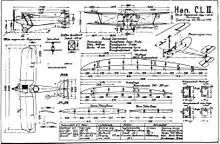| CL.III | |
|---|---|
.jpg.webp) | |
| A German Hannover CL.III shot down by American machine gunners in the First World War. | |
| Role | Ground attack aircraft |
| National origin | Germany |
| Manufacturer | Hannoversche Waggonfabrik |
| Designer | Hermann Dorner |
| First flight | 1917 |
| Primary user | Luftstreitkräfte |
| Number built | 617 |
| Developed from | Hannover CL.II |
The Hannover CL.III was a German military aircraft of World War I. It was a two-seat multi-role aircraft, primarily used as a ground attack machine. Like the other Hannover "light-C-class", or "CL" designated aircraft designed by Hermann Dorner, it included an unusual biplane tail, allowing for a greater firing arc for the tail gunner. Until the introduction of the aircraft, such tails had only been used on larger aircraft.
Design

Compared to the preceding CL.II, the CL.III had redesigned ailerons with aerodynamic balances that overhung the wingtips, a modification that provided greater manoeuvrability, especially at the low levels that the CL.III was expected to be operating at in its new ground-attack role as the Schutzstaffeln (escort squadrons) were reassigned as Schlachtstaffeln (battle squadrons). It was also intended that it should use the excellent Mercedes D.III engine, but the Idflieg gave priority for these engines to fighter production, and most CL.IIIs were produced with the same Argus engine that the CL.II had used. The Argus engined variant was designated CL.IIIa.
After the war, the CL.III was developed into the HaWa F.3, a limousine aircraft with seats for two passengers in an enclosed cabin, where the gunner's cockpit had been.
Variants
- Hannover CL.III
- Powered by a 119-kW (160-hp) Mercedes D.III engine.
- Hannover CL.IIIa
- CL III powered by a 134-kW (180-hp) Argus As.III engine
- Hannover CL.IIIb
- Experimental model of the CL.III, with a two-bay wing.
- HaWa F.3
- A post-war limousine conversion of CL.III aircraft, with a 2-seat limousine cabin behind the pilot's cockpit and additional struts between the wings and fwd undercarriage strut mounts.
Operators
 Latvia (Postwar)
Latvia (Postwar)
Specifications (CL.IIIa)

Data from Windsock Datafile No.23[1] & German Aircraft of the First World War[2]
General characteristics
- Crew: 2
- Length: 7.58 m (24 ft 10 in)
- Wingspan: 11.7 m (38 ft 5 in)
- Height: 2.8 m (9 ft 2 in)
- Wing area: 32.7 m2 (352 sq ft)
- Empty weight: 717 kg (1,581 lb)
- Gross weight: 1,081 kg (2,383 lb)
- Powerplant: 1 × Argus As III 6-cyl. water-cooled in-line Piston engine, 130 kW (180 hp) (CL.IIIa)
- or 1x 119.3 kW (160 hp) Mercedes D.III (CL.III)
Performance
- Maximum speed: 165 km/h (103 mph, 89 kn) at 5,000 m (16,404 ft)
- Endurance: 3 hours
- Service ceiling: 7,500 m (24,600 ft)
- Rate of climb: 3.145 m/s (619.1 ft/min)
- Time to altitude: 1,000 m (3,281 ft) in 5 minutes 18 seconds
Armament
- Guns: 2; one synchronized 7.92 mm (0.323 in) LMG 08/15 machine gun firing forward, single ring-mounted Parabellum MG 14 in observer's cockpit
See also
Related lists
References
Bibliography
- Gray, Peter; Owen Thetford (1970). German Aircraft of the First World War (2nd ed.). London: Putnam & Company Ltd. pp. 150–153. ISBN 0-370-00103-6.
- Grosz, Peter M, Windsock Datafile No.23-Hannover Cl.III, Albatros Publications, 1990. ISBN 0-948414-27-8
- Klaauw, Bart van der (March–April 1999). "Unexpected Windfalls: Accidentally or Deliberately, More than 100 Aircraft 'arrived' in Dutch Territory During the Great War". Air Enthusiast (80): 54–59. ISSN 0143-5450.